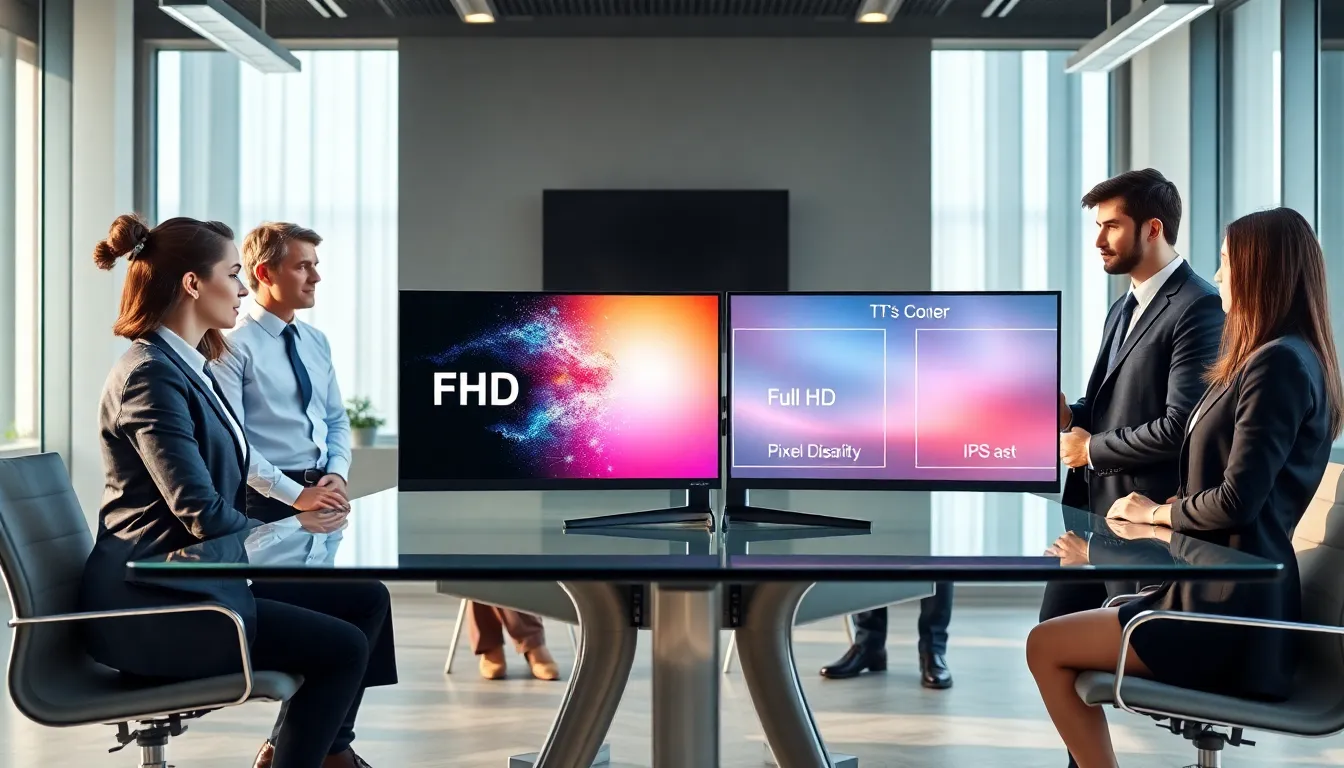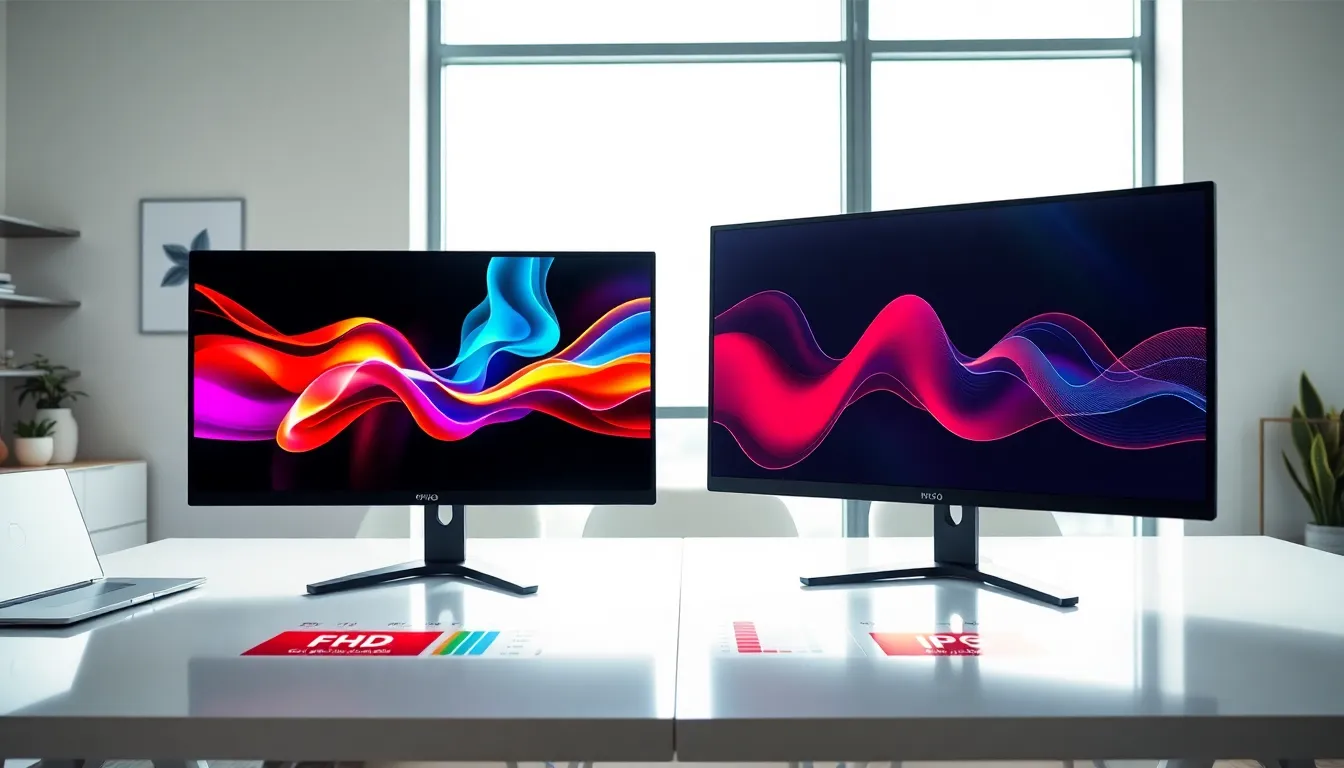In a world where visuals are everything, whether for gaming, design, or binge-watching your favorite shows, understanding display technologies is crucial. So, what’s the real difference between FHD and IPS displays? Jump into this article, where pixels come alive. From vibrant colors to pixel puns, we’ll break down these technologies in a way that’s not just educational but also entertaining, because we can’t all be serious all the time, right? Let’s unravel the pixelated mysteries of FHD and IPS.
FHD vs IPS

Defining FHD Resolution
FHD, or Full HD, refers to a screen resolution of 1920 x 1080 pixels. This means that a display boasts over 2 million pixels, providing sharp detail and vibrant images. For most users, this is more than enough to enjoy movies, play games, or work on projects without feeling like they’re squinting to see fine details.
Benefits of FHD Displays
FHD displays offer a few compelling benefits. For starters, they tend to be less expensive than their higher-resolution counterparts, making them a go-to choice for budget-conscious consumers. Besides, FHD monitors generally provide good image quality, ensuring that video streaming and graphics-heavy applications look great. They also require less processing power, which is a boon for those using less robust systems. Overall, FHD offers a solid compromise between visual fidelity and cost, making it a popular choice among everyday users.
What Is IPS?
How IPS Technology Works
IPS, or In-Plane Switching, is a technology used in liquid crystal displays (LCDs) to enhance color reproduction and viewing angles. Unlike traditional LCDs, which can suffer from color distortion when viewed from off-angles, IPS panels maintain their vibrant colors and contrast regardless of the viewer’s position. This works by aligning the liquid crystals in the same plane, hence the name “In-Plane Switching.”
Advantages of IPS Displays
IPS displays shine when it comes to color accuracy and image consistency. Artists and photo editors often rely on IPS technology for its superior color gamut and consistency across wide viewing angles. These displays excel in creative workflows where color integrity is essential. Besides, IPS panels typically provide better contrast and more vibrant colors, making them a favorite among gamers and multimedia enthusiasts.
FHD Vs IPS: Key Differences
Image Quality Comparison
While FHD resolves 1080p definitions, IPS addresses image quality through technologically enhanced color performance. An FHD panel might show images sharply at a distance, but it won’t compete with the brightness and depth that an IPS panel can offer. Gamers may find that IPS displays provide smoother gradients and more accurate colors during intense gameplay.
Viewing Angles and Color Accuracy
Viewing angles are yet another battleground where IPS takes the crown. FHD monitors can exhibit color shifts when viewed from the side, whereas IPS displays allow users to see vibrant colors from nearly all angles. This makes them superior for multi-user scenarios, like watching movies with friends, where everyone deserves to see the action unfold.
Response Times and Refresh Rates
When it comes to response times and refresh rates, the conversation gets a bit nuanced. FHD monitors can often achieve higher refresh rates, making them excellent for competitive gaming. But, the delay in response times for IPS panels has shrunk much over recent years. Modern IPS displays can deliver refresh rates that satisfy the needs of avid gamers, balancing color accuracy with performance.
Applications and Use Cases
FHD Displays in Various Settings
FHD displays find their ways into homes, offices, and even gaming setups. They’re ideal for general-purpose computing, media consumption, and casual gaming. Their affordability means that they are often found in budget TVs and monitors, appealing to a wider audience. Many users enjoy watching their favorite shows in stunning FHD without needing to expensive.
IPS Displays in Creative Workflows
Conversely, IPS displays are particularly favored in creative sectors. Photographers and graphic designers use these monitors to ensure that the colors they see are true to life. It’s not just about aesthetics: even industries where visual presentation matters greatly, like marketing or product design, rely on IPS panels to create stunning visuals that accurately represent the final product.
Cost Considerations: FHD vs. IPS
Price Points and Market Trends
When comparing FHD and IPS, cost is an essential factor. FHD displays tend to be more affordable and widely available compared to IPS counterparts. This makes them the go-to option for budget-minded consumers or those less concerned with perfect color fidelity.
Value for Different Users
Eventually, the value of each type of display hinges on the user’s needs. A casual gamer or someone who streams shows occasionally would likely be satisfied with an FHD display. In contrast, a content creator or harder-core gamer might find the investment in an IPS display worth every penny. Each type has its target audience, appealing to varying preferences and use cases.

